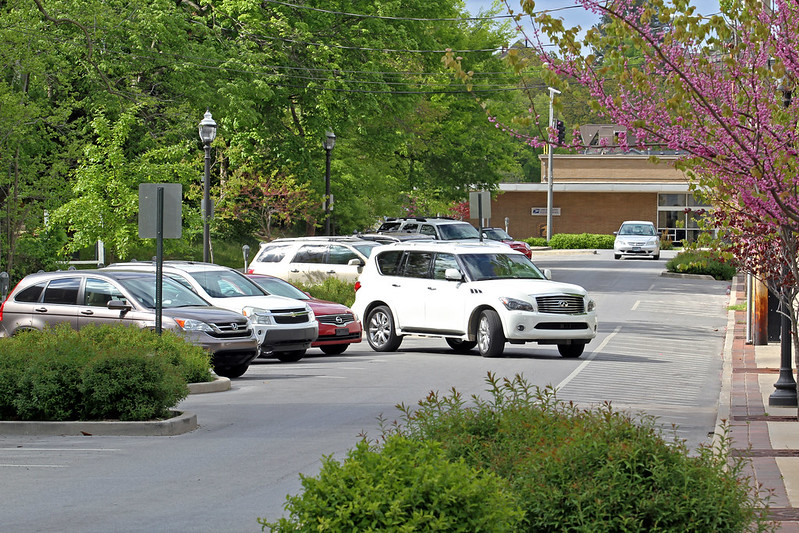
A driver backs into a parking space Thursday on Block Avenue in downtown Fayetteville.
Photo: Todd Gill, Flyer staff
After four years of practice, some residents are still struggling with back-in parking in downtown Fayetteville.
At the request of several residents, aldermen this week will discuss whether to change the 28 back-in parking spaces at the north end of Block Avenue to a more traditional head-in design.
It’s not the first time the city has discussed making changes to the parking setup.
A group of residents asked the city’s Transportation Committee to explore changing the setup three months after back-in parking was completed in July 2010, but after seeing the cost estimates to change the design, the committee voted to keep the plan in place.
Back-in parking was introduced as part of the Block Avenue Enhancement Project. The plan was to create a safer, more pedestrian-friendly, aesthetically pleasing link between Dickson Street and the downtown square, while also improving the water, sewer, and drainage infrastructure. The project included new sidewalks, street trees, decorative street lighting, and a complete overhaul of the streetscape.
It was an unconventional design, but officials said back-in parking was increasingly being implemented throughout the United States due to its inherent safety advantages. The idea is that back-in parking is safer than head-in parking, mostly because it can reduce the chances of collisions between cars backing blindly out of parking spaces and bicycles and vehicles in the lane of travel. Also, safety is said to be improved for people loading and unloading their vehicles because their doors and trunk open toward the sidewalk instead of the street.
Arguments for change

The 28 back-in parking spaces are located at the north end of Block Avenue between Dickson and Spring streets. The remaining angled spaces are head-in parking.
Todd Gill
“I find it very difficult to negotiate,” said Nancy Bittle, a Block Avenue patron.
Bittle said she once had to circle the block twice before she was able to back into a parking space. Each time she stopped to park, the vehicle behind her was too close for her to back up. Once the road was clear, Bittle said she still had trouble parking her car.
“I ended up – after a couple of stabs at it – opening the driver-side door, hanging out watching the stripe so I could get into the parking between the lines while driving with my right arm,” she said. “This is how I now park on Block Street when I go down there.”
Camille Garland, a stylist at Shag Hair Salon, 224 N. Block Ave., said she has heard complaints “every single day” since back-in parking was built.
Garland said she once lost a customer who blew out a tire after hitting the curb while backing into a parking space.
“You do that two or three times and you’re done,” said Garland. “It’s just not worth it.”
Options for change
The options for changing back-in parking are the same as in 2010, but are slightly more expensive due to cost increases for materials.
Option 1 is to tear out the concrete islands and re-build them in the opposite direction before milling and re-striping the street. This option would remove three of the 28 parking spaces between Dickson and Spring streets, and would cost about $42,000.
Option 2 is to simply mill the street and re-stripe the parking lines in the opposite direction. The work would cost about $28,000, and would remove eight of the 28 parking spaces.
Arguments against change

The 2010 Block Avenue Enhancement Project included building new sidewalks, adding street trees and installing decorative street lighting.
Todd Gill
Tom Overbey, who owns an office building with six business tenants at the corner of Block Avenue and Spring Street, said the back-in parking should stay.
For starters, Overbey said most people who park on Block Avenue have no trouble backing into a parking space. He said his window overlooks the street, and he’s able to see about 75 percent of the block from his office.
“My observation is that well over 90 percent of the people have no problems pulling in, stopping, backing up and parking,” said Overbey.
Plus, he said with several undeveloped lots just waiting to be built upon, it’s important to keep as many parking spaces as possible along Block Avenue.
“There will be a bigger and bigger demand for parking in that block of Block Avenue as those properties develop,” said Overbey.
City perspective
Alderman Justin Tennant said whatever safety improvements the city gained by installing back-in parking weren’t worth the hassle created by having to back into a parking space.
“I think it’s time that we admit our mistake,” said Tennant. “I don’t think anybody did anything wrong at the beginning. I remember hearing about it at first and I thought, ‘Well that might be kind of a neat idea.’
“But I think if it was such a great idea, we would have done it somewhere else in the city.”
Tennant said the question in his mind is not whether to change back-in parking.
“The question is, ‘Is it worth $40,000 to do it,'” he said.
City Engineer Chris Brown disagrees, and said back-in parking should stay.
Brown said while he’s not surprised that there have been some complaints, he stands by the safety benefits of back-in parking as presented in 2010.
With a transportation work plan already in place for 2014, Brown said aldermen would need to take money from an already-approved project or re-prioritize future projects if they decide to redo Block Avenue.
Aldermen will begin formal discussions about Block Avenue during the next City Council meeting on Tuesday, May 6.

